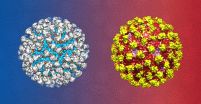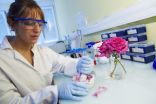(Press-News.org) Astronomers are gearing up for high-energy fireworks coming in early 2018, when a stellar remnant the size of a city meets one of the brightest stars in our galaxy. The cosmic light show will occur when a pulsar discovered by NASA's Fermi Gamma-ray Space Telescope swings by its companion star. Scientists plan a global campaign to watch the event from radio wavelengths to the highest-energy gamma rays detectable.
The pulsar, known as J2032+4127 (J2032 for short), is the crushed core of a massive star that exploded as a supernova. It is a magnetized ball about 12 miles across, or about the size of Washington, weighing almost twice the sun's mass and spinning seven times a second. J2032's rapid spin and strong magnetic field together produce a lighthouse-like beam detectable when it sweeps our way. Astronomers find most pulsars through radio emissions, but Fermi's Large Area Telescope (LAT) finds them through pulses of gamma rays, the most energetic form of light.
J2032 was found in 2009 through a so-called blind search of LAT data. Using this technique, astronomers can find pulsars whose radio beams may not be pointed precisely in our direction and are therefore much harder to detect.
"Two dozen pulsars were discovered this way in the first year of LAT data alone, including J2032," said David Thompson, a Fermi deputy project scientist at NASA's Goddard Space Flight Center in Greenbelt, Maryland. "Nearly all of them would not have been found without Fermi."
Once they knew exactly where to look, radio astronomers also were able to detect J2032. A team at the Jodrell Bank Centre for Astrophysics at the University of Manchester in the U.K. kept tabs on the object from 2010 through 2014. And they noticed something odd.
"We detected strange variations in the rotation and the rate at which the rotation slows down, behavior we have not seen in any other isolated pulsar," said Andrew Lyne, professor of physics at the University of Manchester. "Ultimately, we realized these peculiarities were caused by motion around another star, making this the longest-period binary system containing a radio pulsar."
The massive star tugging on the pulsar is named MT91 213. Classified as a Be star, the companion is 15 times the mass of the sun and shines 10,000 times brighter. Be stars drive strong outflows, called stellar winds, and are embedded in large disks of gas and dust.
"When we discovered this pulsar in 2009, we noticed that it was in the same direction as this massive star in the constellation Cygnus, but our initial measurements did not give any evidence that either star was a member of a binary system," explained Paul Ray, an astrophysicist at the Naval Research Laboratory in Washington. "The only way to escape that conclusion was if the binary system had a very long orbital period, much longer than the longest known pulsar-massive star binary at the time, which seemed unlikely."
Following an elongated orbit lasting about 25 years, the pulsar passes closest to its partner once each circuit. Whipping around its companion in early 2018, the pulsar will plunge through the surrounding disk and trigger astrophysical fireworks. It will serve as a probe to help astronomers measure the massive star's gravity, magnetic field, stellar wind and disk properties.
Several features combine to make this an exceptional binary. Out of six similar systems where the massive star uses hydrogen as its central energy source, J2032's has the greatest combined mass, the longest orbital period, and, at a distance of about 5,000 light-years, is closest to Earth.
"This forewarning of the energetic fireworks expected at closest approach in three years' time allows us to prepare to study the system across the entire electromagnetic spectrum with the largest telescopes," added Ben Stappers, a professor of astrophysics at the University of Manchester.
Astronomers think the supernova explosion that created the pulsar also kicked it into its eccentric orbit, nearly tearing the binary apart in the process. A study of the system led by Lyne and including Ray and Stappers was published June 16 in the journal Monthly Notices of the Royal Astronomical Society.
INFORMATION:
MINNEAPOLIS - A new study suggests that genes may not be to blame for the increased risk of heart disease some studies have shown in people with migraine, especially those with migraine with aura. The research is published during Headache/Migraine Awareness Month in the inaugural issue of the journal Neurology® Genetics, an open access, or free to the public, online-only, peer-reviewed journal from the American Academy of Neurology. Aura are sensations that come before the headache, often visual disturbances such as flashing lights.
"Surprisingly, when we looked ...
BOSTON -- A new study led by scientists at Beth Israel Deaconess Medical Center (BIDMC) shows that an HIV-1 vaccine regimen, involving a viral vector boosted with a purified envelope protein, provided complete protection in half of the vaccinated non-human primates (NHPs) against a series of six repeated challenges with simian immunodeficiency virus (SIV), a virus similar to HIV that infects NHPs. These findings are published online today in Science.
Based on these pre-clinical data, the HIV-1 version of this vaccine regimen is now being evaluated in an ongoing Phase ...
One more piece and we are done! A research team led by the Duke-NUS Graduate Medical School Singapore (Duke-NUS) has found the second-to-last piece of the puzzle needed to potentially cure or treat dengue. This is welcome news as the dengue virus infects about 400 million people worldwide annually, and there is currently no licensed vaccine available to treat it.
Associate Professor Shee-Mei Lok and Research Fellow Guntur Fibriansah, from the Duke-NUS Emerging Infectious Diseases (EID) Programme, led research that showed how an antibody neutralises dengue virus serotype ...
In a new Science study, Duke-NUS Graduate Medical School Singapore (Duke-NUS) scientists have identified how small changes in dengue's viral genome can affect the virus' ability to manipulate human immune defences and spread more efficiently. This research is the first of its kind that examined the dengue virus starting from broad population level observations and then linked it to specific molecular interactions, to explain an outbreak. This work provides a framework for identifying genomic differences within the virus that are important for epidemic spread.
Dengue virus ...
This news release is available in Japanese. Detailed tabletop experiments are helping researchers understand how Earth's landscapes erode to form networks of hills and valleys. The findings, which highlight a balance between processes that send sediments down hills and those that wash them out of valleys, might also help researchers predict how climate change could transform landscapes in the future. Kristin Sweeney and colleagues developed a laboratory device that mimicked the processes that smooth or disturb soil to make hillslopes, and those that cut it away to make ...
This news release is available in Japanese. Researchers have discovered that a human antibody specific to dengue virus serotype 2, called 2D22, protects mice from a lethal form of the virus -- and they suggest that the site where 2D22 binds to the virus could represent a potential vaccine target. The mosquito-borne virus, which infects nearly 400 million people around the world each year, has four distinct serotypes, or variations, and there is currently no protective vaccine available. Recent phase 3 clinical trials of a potential vaccine candidate showed poor efficacy, ...
Why is the seahorse's tail square? An international team of researchers has found the answer and it could lead to building better robots and medical devices. In a nutshell, a tail made of square, overlapping segments makes for better armor than a cylindrical tail. It's also better at gripping and grasping. Researchers describe their findings in the July 3 issue of Science.
"Almost all animal tails have circular or oval cross-sections--but not the seahorse's. We wondered why," said Michael Porter, an assistant professor in mechanical engineering at Clemson University and ...
This news release is available in Japanese. Researchers working with roses have identified an enzyme, known as RhNUDX1, which plays a key role in producing the flowers' sweet fragrances. These ornamental plants, which provide essential oils for perfumes and cosmetics, have been bred mostly for their visual traits, and their once-strong scents have faded over the generations. Restoring their fragrant odors will require a better understanding of the rose scent biosynthesis pathway. Until now, most studies of rose fragrance have focused on a biosynthetic pathway that generates ...
This news release is available in Japanese. The seahorse tail is square because this shape is better at resisting damage and at grasping than a circular tail would be, a new engineering study shows. Insights gleaned from the study could inspire new armor and advances in robotics, the authors say. While most animals with tails, including certain monkeys, lizards and rodents, have soft, cylindrical-shaped appendages, tails of seahorses are organized into square prisms surrounded by bony plates. To better understand why the seahorse tail deviates from the norm, and what ...
Mass killings and school shootings in the U.S. appear to be contagious, according to a team of scientists from Arizona State University and Northeastern Illinois University.
Study author Sherry Towers, research professor in the ASU Simon A. Levin Mathematical, Computational and Modeling Sciences Center, explained, "The hallmark of contagion is observing patterns of many events that are bunched in time, rather than occurring randomly in time."
Her team examined databases on past high-profile mass killings and school shootings in the U.S. and fit a contagion model to ...




